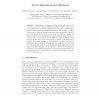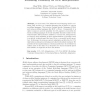MODELS
2010
Springer
13 years 10 months ago
2010
Springer
Model-driven software development (MDSD) has been on the rise over the past few years and is becoming more and more mature. However, evaluation in real-life industrial context is s...
MODELS
2010
Springer
13 years 10 months ago
2010
Springer
In feature models’ construction, one basic task is to ensure the consistency of feature models, which often involves detecting and fixing of inconsistencies in feature models. S...
MODELS
2010
Springer
13 years 10 months ago
2010
Springer
Abstract. Collections are omnipresent within models: collections of references can represent relations between objects, and collections of values can represent object attributes. C...
MODELS
2010
Springer
13 years 10 months ago
2010
Springer
Abstract. In recent years, OCL advanced from a language used to constrain UML models to a constraint language that is applied to various modelling languages. This includes Domain S...
MODELS
2010
Springer
13 years 10 months ago
2010
Springer
A feature represents a functional requirement fulfilled by a system. Since many maintenance tasks are expressed in terms of features, it is important to establish the corresponden...
MODELS
2010
Springer
13 years 10 months ago
2010
Springer
Abstract. UML activity diagrams have become an established notamodel control and data flow on various levels of abstraction, ranging from fine-grained descriptions of algorithms ...
MODELS
2010
Springer
13 years 10 months ago
2010
Springer
Formal analysis can be used to verify that a model of the system adheres to its requirements. As such, traditional formal analysis focuses on whether known (desired) system propert...
MODELS
2010
Springer
13 years 10 months ago
2010
Springer


